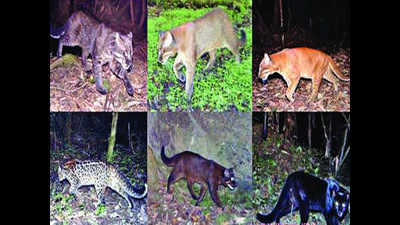- News
- City News
- itanagar News
- Arunachal Pradesh valley has most diverse range of Asiatic golden cat
Trending
This story is from June 14, 2019
Arunachal Pradesh valley has most diverse range of Asiatic golden cat
The misty jungles of the Dibang Valley in Arunachal Pradesh could hold the key to the "evolutionary puzzle" of polymorphism - why a variation of form crops up in a single species inhabiting an area.

The 9,129-sq-km Dibang valley is home to six different colour variations of the Asiatic golden cat and could hold key to ‘evolutionary puzzle’ of polymorphism
GUWAHATI: The misty jungles of the Dibang Valley in Arunachal Pradesh could hold the key to the "evolutionary puzzle" of polymorphism - why a variation of form crops up in a single species inhabiting an area.
The 9,129-sq-km valley is home to the Asiatic golden cat (Catopuma temminckii) in six different colour variations, as Indian scientists from the international conservation charity organization Zoological Society of London (ZSL) and University College London found out.This is the most diverse range of colour morphs found in a single locality, according to the study published in the Ecological Society of America's journal, 'Ecology', on June 7.
"We now know the Dibang Valley hosts the world's most diverse range of colour morphs of a wild cat species ever reported in one site, but we are only just starting to understand this rare ecological phenomenon," said Sahil Nijhawan, lead author of the study and British Academy Fellow at ZSL's Institute of Zoology and UCL. A colour morph is an occurrence of a variation of colour, a discrete one, in a species because of mutation. It takes hold of a population through natural selection.
The Asiatic golden cat - the largest group of small Asian felines - is found across eastern Nepal, through northeast India, Myanmar, Thailand and China, all the way to Sumatra and Indonesia. It is listed as a Near Threatened species on the International Union for Conservation of Nature's Red List of Threatened Species. While it was known that the species exhibits many variations, the extent had not been explored.
Why these colour morphs have endured could be put down to the one keystone of evolution - adaptability.
Of these, tightly-rosetted - initially called "leopard-like rosettes tightly spaced on its grey coat - is an entirely new colour morph, found in community-owned forests. The cinnamon and ocelot morphs are also unique - previously found in Bhutan and China, their occurrence has been recorded in India for the first time.
Why these colour morphs have endured could be put down to the one keystone of evolution - adaptability.
The 9,129-sq-km valley is home to the Asiatic golden cat (Catopuma temminckii) in six different colour variations, as Indian scientists from the international conservation charity organization Zoological Society of London (ZSL) and University College London found out.This is the most diverse range of colour morphs found in a single locality, according to the study published in the Ecological Society of America's journal, 'Ecology', on June 7.
"We now know the Dibang Valley hosts the world's most diverse range of colour morphs of a wild cat species ever reported in one site, but we are only just starting to understand this rare ecological phenomenon," said Sahil Nijhawan, lead author of the study and British Academy Fellow at ZSL's Institute of Zoology and UCL. A colour morph is an occurrence of a variation of colour, a discrete one, in a species because of mutation. It takes hold of a population through natural selection.
The Asiatic golden cat - the largest group of small Asian felines - is found across eastern Nepal, through northeast India, Myanmar, Thailand and China, all the way to Sumatra and Indonesia. It is listed as a Near Threatened species on the International Union for Conservation of Nature's Red List of Threatened Species. While it was known that the species exhibits many variations, the extent had not been explored.
So in 2014, Sahil and his colleagues set out to study the feline species in the Dibang Valley. They conducted a camera camera trap study across 223 locations of the Dibang Valley - in both community forest and protected areas - between January 2014 and September 2015. That was when they noticed something strange. In the 75 independent photographic records of the Asiatic golden cat, they found groups that looked entirely different from each other. The result - documentation of six colour morphs: tightly-rosetted, cinnamon, ocelot, melanistic, grey and golden.
Why these colour morphs have endured could be put down to the one keystone of evolution - adaptability.
Of these, tightly-rosetted - initially called "leopard-like rosettes tightly spaced on its grey coat - is an entirely new colour morph, found in community-owned forests. The cinnamon and ocelot morphs are also unique - previously found in Bhutan and China, their occurrence has been recorded in India for the first time.
Why these colour morphs have endured could be put down to the one keystone of evolution - adaptability.
End of Article
FOLLOW US ON SOCIAL MEDIA










